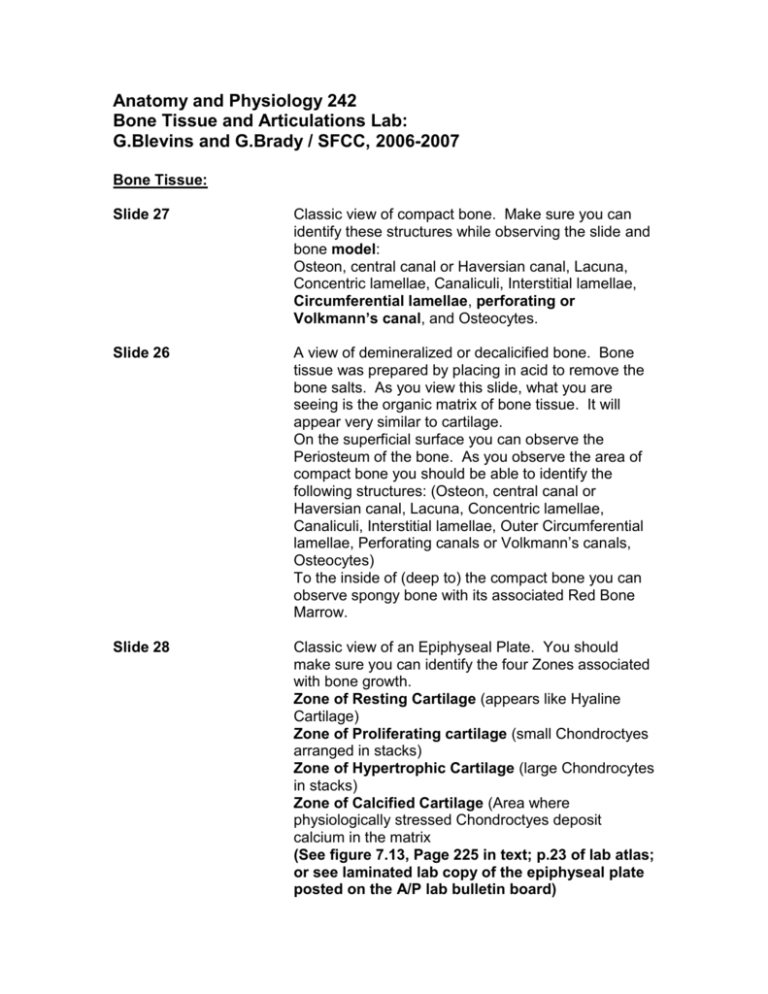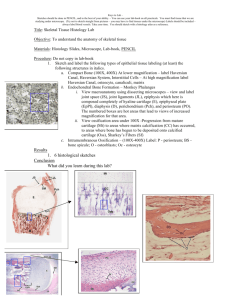Anatomy and Physiology 242
advertisement

Anatomy and Physiology 242 Bone Tissue and Articulations Lab: G.Blevins and G.Brady / SFCC, 2006-2007 Bone Tissue: Slide 27 Classic view of compact bone. Make sure you can identify these structures while observing the slide and bone model: Osteon, central canal or Haversian canal, Lacuna, Concentric lamellae, Canaliculi, Interstitial lamellae, Circumferential lamellae, perforating or Volkmann’s canal, and Osteocytes. Slide 26 A view of demineralized or decalicified bone. Bone tissue was prepared by placing in acid to remove the bone salts. As you view this slide, what you are seeing is the organic matrix of bone tissue. It will appear very similar to cartilage. On the superficial surface you can observe the Periosteum of the bone. As you observe the area of compact bone you should be able to identify the following structures: (Osteon, central canal or Haversian canal, Lacuna, Concentric lamellae, Canaliculi, Interstitial lamellae, Outer Circumferential lamellae, Perforating canals or Volkmann’s canals, Osteocytes) To the inside of (deep to) the compact bone you can observe spongy bone with its associated Red Bone Marrow. Slide 28 Classic view of an Epiphyseal Plate. You should make sure you can identify the four Zones associated with bone growth. Zone of Resting Cartilage (appears like Hyaline Cartilage) Zone of Proliferating cartilage (small Chondroctyes arranged in stacks) Zone of Hypertrophic Cartilage (large Chondrocytes in stacks) Zone of Calcified Cartilage (Area where physiologically stressed Chondroctyes deposit calcium in the matrix (See figure 7.13, Page 225 in text; p.23 of lab atlas; or see laminated lab copy of the epiphyseal plate posted on the A/P lab bulletin board) Page 2 of 3 Articulations: Be able to identify the different joints on the skeletons available in lab based upon their Functional Classification. (Synarthroses, Amphiarthroses, and Diarthroses) Be able to identify the different joints on the skeletons available in lab based upon their Structural Classification. Fibrous: Sutures and Syndesmoses Cartilaginous: Symphyses and Synchondroses Synovial: All Diarthroses Review the Tibofemoral (knee) joint model available in lab. Make sure you can identify the following parts of the Tibofemoral joint: Anterior Cruciate ligament (ACL), Posterior Cruciate ligament (PCL), Lateral meniscus, Medial meniscus, Fibular (Lateral) collateral ligament, Tibial (Medial) collateral ligament. Note: The knee is a modified hinge joint. Structurally, it is a synovial joint. Functionally, it is a diarthrosis. Using yourself or your lab partner as a model, make sure you can identify the following movements that occur at Synovial joints: Flexion Adduction Pronation Eversion Hyperextension Extention Rotation Supination Dorsifexion Abduction Circumduction Inversion Plantar Flexion Review the x-ray films available in lab and see if you can identify the bones. Review the Frozen Calf bone available in lab. Make sure you can identify the structural parts of this long bone. (Diaphysis, Epiphysis, Medullary cavity, Compact bone, Spongy Bone, Periosteum, Endosteum, Red bone Marrow, Yellow Bone Marrow, Epiphyseal plate, Articular Cartilage) Observe the Plastic slide of the Auditory Ossicles available as a demonstration. View these middle ear bones through the dissection scope and on the model. Make sure you can identify them by their correct names. (Malleus, Incus, and Stapes) P. 3 of 3 HISTOLOGY: Be able to identify the following in the microscope, photographs, diagrams, or models: Periosteum Endosteum Marrow Ground bone Osteocytes Osteoblasts Lacunae Canaliculi Compact bone Volkmann’s (perforating) canals Osteon (Haversian system) Central (Haversian) canal Concentric lamellae Circumferential lamellae Interstitial lamellae Spongy bone Trabeculae Cartilage Chondrocytes Lacunae Fibrocartilage Hyaline cartilage Endochondral ossification Epiphyseal plate 4 Zones of epiphyseal plate GROSS ANATOMY: Be able to identify on the skeleton, in photographs, diagrams or models, the following: Bone Anatomy Diaphysis Medullary (marrow) cavity Epiphysis Epiphyseal line Articular cartilage Red and Yellow bone marrow Compact bone Nutrient foramen Spongy bone Trabeculae Periosteum





